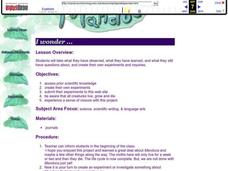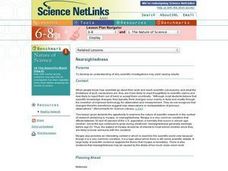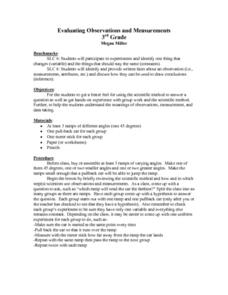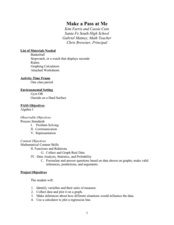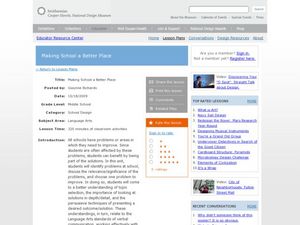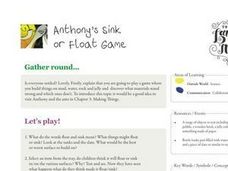Curated OER
Observation
Young scholars practice observation skills by discussing physical attributes of family artifacts. They determine what characteristics of an object are considered important details.
Curated OER
Weather Maps and Prediction
Second graders point out symbols for high and low pressure that would be found on weather maps. They break into small groups and use a copy of the weather maps file to make observations about the maps and come up with an explanation of...
Curated OER
Name that animal
A great way to classify organisms, is by counting the number of legs it has or how it moves. Little ones count the legs on five different creatures, then match the leg count to the proper animal name. Tip: Have them come up with other...
Curated OER
I Wonder...
Students review information they have gathered from previous lessons. They create their own experiments and carry them out. They reflect on the project as a whole.
Curated OER
Nearsightedness
Examine the processes scientists go through to develop their conclusions. Using the internet, research the problem of nearsightedness and identify anyone they know with the condition. Discover the debate in the science world on this...
Curated OER
The Eyes Have It
Students create a bulletin board using a digital camera. In this creative arts lesson, students take photos of one another's faces and eyes. Students try to match the eyes to the face.
Curated OER
Comparing the Amoeba to Paramecium
This laboratory activity is valuable practice in comparing features of different organisms. You could use it to introduce junior biologists to protozoans. The materials and procudures for the learners are simple, and analysis...
Curated OER
Time-Lapsed Observations
Learners explore timed observations for science investigations. They record ideas on a chart related to a classroom closed terrarium. They repeat their observations for several days and time observations for changing shadows during the...
Curated OER
Making Sense of Unusual Findings
Students work on the development of observation skills and seeing how they can be used in different contexts. The lesson is good for helping the beginner and novice, along with encouraging and reminding the expert observer of right...
Curated OER
Evaluating Observations and Measurements
Third graders review the scientific method and how and in which steps scientists use observations and measurements. Then as a class, they hypothesize which ramp will send the car the farthest. They break into groups and send cars down a...
Curated OER
Becoming a "Seer" -- The Observation of Place
Learners discover that effective observations can help their writing. They realize their sense of place and how they view the world around them. They write about their place and share with the class.
Curated OER
Observation Journal
In this ocean life worksheet, students observe the plants, animals, human activity, park rules/local laws, at a specific location. Students also observe any activity in neighborhoods, the water sources for the area, the water uses, and...
Curated OER
How Do You Make A Tornado?
Students create a tornado in a bottle. In this climate and weather lesson, students review basic information about tornadoes and thunderstorms. Students make a tornado in a bottle and write about what they learned from the project....
Curated OER
Make a Pass at Me
Learners identify different types of functions and units of measurements. In this statistics lesson plan, students will collect data, graph their data and make predictions about their data. They plot a linear regression graph.
Curated OER
Making School a Better Place.
Middle schoolers study the problems in their school and work on solutions for those problems. In this writing process instructional activity, students analyze a problem and work as a team to find a solution. Middle schoolers...
Curated OER
Scientific Thinking
Students participate in four different activities which reinforce an understanding of they way scientists think about the world. They make careful observations of two different pennies, write the procedure for making a peanut butter and...
Curated OER
What's the Weather?
Second graders make daily weather observations, record them with appropriate stickers on a chart, and then summarize them at the end of the week in the form of a bar graph.
Curated OER
Taking Notes / Making Conclusions Worksheet
In this worlds of work and play activity, students make observations about home architecture and gardening as they walk through a neighborhood. Students answer 16 questions that require them to take notes and draw conclusions about what...
Curated OER
Anthony's sink or float game
Students explore the concepts of float and sink by playing a game where they build things on mud, water, rock and jelly. In this Anthony's sink or float game instructional activity, students discover what materials remain strong in...
Curated OER
The Structure and Function of Cells: Making Biology Fun
Investigate life below a microscope, and cells and discover the differences between plant and animal cells.
Curated OER
Investigating What Makes Fruit Go Brown
Is there anything that can be done to slow the browning of fruit once it has been cut? High schoolers determine the answer through five different investigations involving apples, potatoes, and chemical reactions. After each experiment,...
Curated OER
Parachute Drop
Learners will have fun creating a parachute to collect data with. They will construct the parachute in small groups, measure the materials, and create an observation sheet. Then they drop the parachute and make predictions about how long...
Curated OER
Technology Integration Project Weather Unit Plan
Students use a variety of technology-assisted weather observation tools to observe and record local weather. They identify, measure and record weather conditions, summarize types of clouds and make graphs of their observations. Students...
Other popular searches
- Making Observations Science
- Making Observations Biology
- Ell Making Observations
- Making Observations in Science
- Ell + Making Observations





